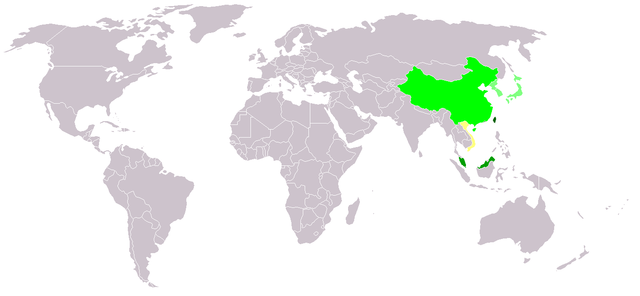
File:Map-Chinese Characters.png

| |
This is a file from the Wikimedia Commons. Information from its description page there is shown below.
Commons is a freely licensed media file repository. You can help. |
Contents |
Summary (en)
Countries (modern boundaries drawn) where Chinese characters were/are used in its official/dominant language or at least one of its official/dominant languages.
- !Dark Green - Traditional Chinese characters used exclusively or almost exclusively (Taiwan, Hong Kong, and Macau).
- !Medium Green - Simplified Chinese characters used formally but traditional characters continue to be used widely (Singapore and Malaysia).
- !Green - Simplified Chinese characters used exclusively or almost exclusively (Mainland China)
- !Light Green- Chinese characters used in conjunction with other systems of writing in the same language (Japan and South Korea).
- !Light Yellow - Chinese characters were once used in the official language but is not used any more (North Korea and Viet Nam).
簡介 (zh-hant)
曾在或現在官方或主流語文中使用 漢字的國家和地區(以現代邊界畫出)
- !深綠色:現在僅用或幾乎僅用傳統漢字(正體/繁體)的地區(台灣、香港、澳門)。
- !青綠色:現在正式採用簡化漢字,但傳統漢字仍廣泛使用的地區(新加坡、馬來西亞)。
- !綠色:現在僅用或幾乎僅用簡化漢字的地區(中國大陸)。
- !淺綠色:漢字與其他書寫系統在同一語言並用的地區(日本、南韓)。
- !淺黃色:一度曾在官方語文中用漢字,但現在不再使用的地區(越南、北韓)。
简介 (zh-hans)
曾在或现在官方或主流语文中使用 汉字的国家和地区(以现代边界画出)
- !深绿色:现在仅用或几乎仅用传统汉字(正体/繁体)的地区(台湾、香港、澳门)。
- !青绿色:现在正式采用简化汉字,但传统汉字仍广泛使用的地区(新加坡、马来西亚)。
- !绿色:现在仅用或几乎仅用简化汉字的地区(中国大陆)。
- !青绿色:汉字与其他书写系统在同一语言并用的地区(日本、韩国)。
- !浅黄色:一度曾在官方语文中用汉字,但现在不再使用的地区(越南、朝鲜)。
Описание (ru)
- !Темно-зелёный: Страны, официально или преимущественно использующие традиционные иероглифы (Тайвань, Гонконг, Макао)
- !Зелёный: Малайзия ‒ страна, официально использующая упрощённые иероглифы при частом употреблении традиционных иероглифов
- !Светло-зелёный: Страны, официально использующие упрощённые иероглифы (материковый Китай, Сингапур)
- !Жёлтый: Страны, некогда ранее в своей истории использовавшие иероглифы, но в данное время их уже не использующие (Вьетнам, Северная Корея)
Giới thiệu (vi)
Những quốc gia và vùng lãnh thổ chịu ảnh hưởng của chữ Hán:
- !Xanh lục đậm: chữ Hán phồn thể được dùng chính thức (Trung Hoa Dân Quốc, Ma Cao và Hồng Kông)
- !Xanh lục: chữ Hán giản thể được dùng chính thức nhưng chữ Hán phồn thể vẫn thông dụng (Singapore và Mã Lai)
- !Xanh lá mạ: chữ Hán giản thể được dùng chính thức (CHND Trung Hoa)
- !Xanh lục nhạt: được sử dụng song song với hệ chữ viết khác trong cùng ngôn ngữ (Hàn Quốc và Nhật Bản)
- !Vàng: trước đây đã từng được dùng chính thức nhưng nay không dùng nữa (Mông Cổ, CHDCND Triều Tiên và Việt Nam)
This map was improved or created by the Wikigraphists of the Graphic Lab (fr). You can propose images to clean up, improve, create or translate as well.
বাংলা | català | česky | Deutsch | Deutsch (Sie-Form) | Ελληνικά | English | Esperanto | español | suomi | français | עברית | magyar | Հայերեն | italiano | 한국어 | македонски | Bahasa Melayu | Plattdüütsch | Nederlands | occitan | polski | português | română | русский | slovenščina | svenska | татарча/tatarça | Türkçe | українська | 中文 | 中文(简体) | 中文(繁體) | Zazaki | +/−
From Wikipedia:
- (del) (cur) 22:24, 27 January 2006 . . Codex Sinaiticus (Talk) . . 800x370 (70295 bytes) (more historic than older version that had modern boundaries. Green - Chinese charaters used exclusively Dark Green - Used in competition with other systems Light Green - maximum extent of former historic use [*up til 1900 - does not take into account othe)
Licensing
| Public domainPublic domainfalsefalse |
 |
This work has been released into the public domain by its author, Yug. This applies worldwide. In some countries this may not be legally possible; if so: Yug grants anyone the right to use this work for any purpose, without any conditions, unless such conditions are required by law. Public domainPublic domainfalsefalse |
File usage
Metadata
| Software used |
|
|---|
Did you know...?
All five editions of Schools Wikipedia were compiled by SOS Children's Villages. In 133 nations around the world, SOS Childrens Villages works to bring better education and healthcare to families in desperate need of support. Sponsoring a child is the coolest way to help.
